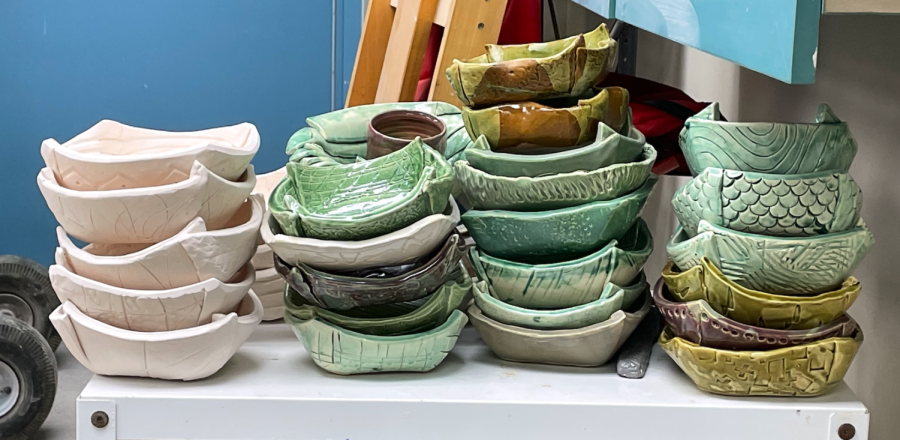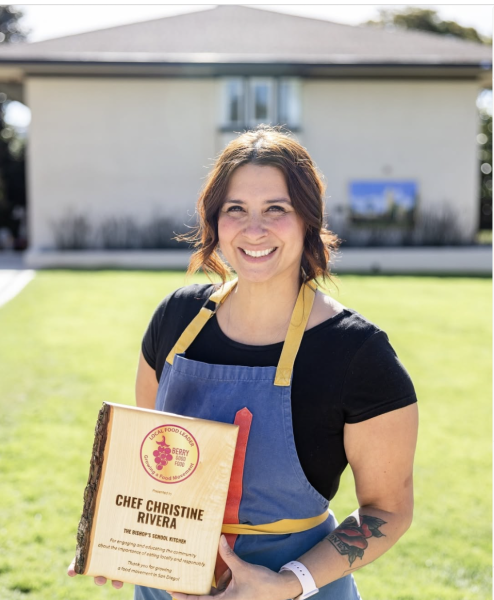Helping By Hand
The Empty Bowls Project at Bishop’s
The bowls in Mr. Gercke’s room are presented in many colors and designs.
In Mr. Jeremy Gercke’s ceramics classes, many Bishop’s students learn how to handcraft bowls, cups, and plates. Using those skills, students can contribute to the Empty Bowls project which is, according to their website, a movement to “raise money for food-related charities to care for and feed the hungry in their communities.”
The project started in Michigan with art teachers Lisa Blackburn and John Hartom in 1990. Hartom wanted to create a charitable organization that invited potters to produce ceramics. His students created bowls, used as serving pieces for fundraising, and guests would keep their bowls. The movement has expanded to the entire US and Canada.
Bishop’s organized pottery sessions specific for Empty Bowls on January 14th and February 4th, with the next on March 23rd. 18 people are allowed to produce bowls during each session. Mr. Gercke explained the project as, “really grassroots, [where] potters get together and donate bowls and ceramics.” Grassroots means a community-driven project that works to act and cause positive economic change for society, rather than a private organization.
Lilian Franqui (‘25) explained bowl crafting. After signing up, “[Mr. Gercke] taught us how to make the bowls by designing the clay and molding it. He then explained that the Empty Bowls Project is a service dedicated to fighting world hunger.” Adelaide Kessler (‘25) described how she decorated her bowls: “I did a striped pattern and flipped it to the other side, and I did another flower pattern.” Mr. Gercke discussed the design process, explaining, “another aspect is there’s a lot of possibilities with creative expression. The bowls need to appeal to people who donate money.” He proudly displayed the bowls, including fish scale patterns, complex lines, influxes of grooves, etched rectangles, waves, and in shiny, glazed colors of turquoise, green and white.
Typically, Bishop’s contributed bowls to the Methodist Church, but this year the bowls will sell at the Annual Bishop’s Spring Auction, said Mr. Gercke. During the auction, “the person that pays the most picks the first bowl, and the bowls that don’t get chosen get donated to the shelters,” said Adelaide. The payments from the bowls are donated to charitable organizations around the city.
According to the students and Mr. Gercke, the project aims to help homelessness and hunger. “You don’t have to solve world hunger, but you can do little things like raising money to help solve the issue,” or spending time on Empty Bowls, said Lilian.
“The money earned is donated to Lucky Ducklings Foundation, which goes to homeless shelters,” Adelaide shared. She also said it was important to help the community, and, she said, “do it with your friends and try something new. It forced me out of my comfort zone.” Mr. Gercke explained the effects he hoped Empty Bowls will have, saying, “I don’t think hunger is going away. But it can be something to contribute in a positive way.”
Talking about how they want their bowls to be used in the future by their new owners, Lilian said, Talking about how they want their bowls to be used in the future by their new owners, Lilian said, “Any way that makes it useful. Even smash it in celebration. Do what you want but remember when using the bowl, you did a small part to end world hunger, which is the best thing you can do.” Adelaide agreed with smashing the bowls, saying, “It’ll help the greater good in the community to release tensions with people.”
This year, a collective 60 bowls have been produced with 30 more in progress. The project has a history at Bishop’s, as Mr. Gercke explained, “Students have been donating bowls since before I started working at Bishop’s in 2010.” As a final note for the future, he hopes to, “contribute to the concept every year.”

Pronouns: They/Them
Favorite food: Tacos forever
Favorite Song: Good Life by Kanye West
Favorite artist: Playboi Carti
Favorite Tower Article:...






